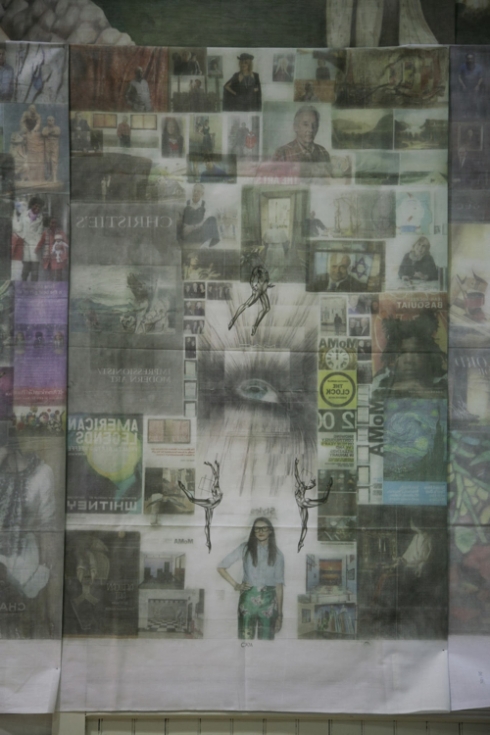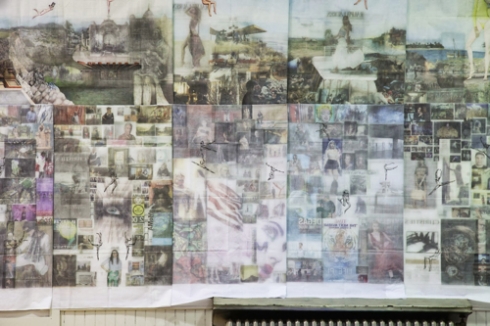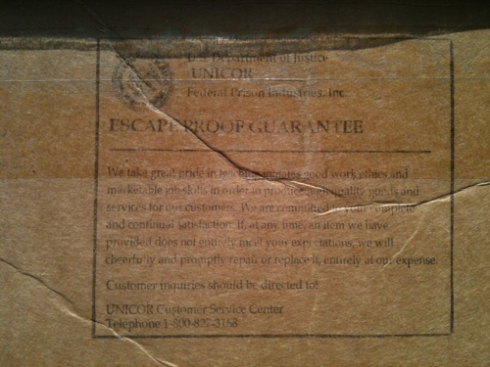You are currently browsing the tag archive for the ‘Bureau of Prisons’ tag.

In a massive 3×9-metre grid, Daniel Schwartz‘s Corrections (above) tiles a satellite view of every facility in the United States’ federal prison system. It’s a literal but effective means to describe the frightening scale of mass incarceration. If we bear in mind that the federal system houses approximately 210,000 prisoners, which is less than one tenth of the total prison population in the US only, then Corrections assumes an even more terrifying edge.
Schwartz created the images, I presume, by means of a customised script based upon the publicly available Google Map API. GPS coordinates inserted into the customised script allow for an automatically captured a satellite view and .jpg of sites (prisons in this case) when the script is run. I make this assumption because this was Josh Begley’s method in creating Prison Map, a similar project.
Corrections presents 1,218 facilities, about one fifth of the 6,000+ locked facilities in the US–including state, county, private and immigration prisons. To present all of the types of all of the United States’ prisons facilities would require a lot of wall space and a lot of double-sided sticky tape. I know this because as part of the Prison Obscura exhibition, I printed 392 images from Josh Begley’s Prison Map. and put them on walls. (See the heavily illustrated point below)

Prison Map, part of the exhibition ‘Prison Obscura’ at Haverford College, PA

Prison Map, part of the exhibition ‘Prison Obscura’ at the University of Michigan, MI

Prison Map, part of the exhibition ‘Prison Obscura’ at Parsons New School, NY

Prison Map, part of the exhibition ‘Prison Obscura’ at Scripps College, CA

Prison Map, part of the exhibition ‘Prison Obscura’ at Newspace, Portland, Oregon
It was my intention to provide a visual backdrop to the computer/screen/console in the gallery at which people navigated Prison Map. Begley had, up to that point, never printed out the images from Prison Map (he did later make and sell large fine art prints), but physical objects were never the primary purpose of the project. Rather, Prison Map was an experiment how Google Earth could be manipulated to produce an image-set based upon a dataset; an experiment in how a corporation’s empire of images could be bent toward a social justice conversation. I’m speculating on this because I wonder if, after the point of automated capture, Schwartz intended to print out Corrections and stick it on a wall? There are arguments for doing so as valid as those for maintaining it as a virtual user experience. I should give Schwartz a phone-call.
I mention this, also, because there are other parellels between the work of Schwartz and Begley. In tackling the issue and enormity of the US/Mexico border, Begley made the film Best of Luck with the Wall and Schwartz made two accordion books. Both stitched together staellite images that tracked the entire border. One virtual, one physical.
On the topic of gun use, Begley made Officer Involved, which automatically captured Google Street View (GSV) scenes of the sites in which law enforcement officers killed a citizen, and Schwartz made Death By Gun, which maps firearm homicides in Los Angeles County carried out by citizens.
Both Schwartz and Begley are interested in tempting users to reimagine their smartphones’ purpose. Both are interested in having content “enter” the phone in real time. Once installed the Death By Gun app automatically saves the auto-generated images to the camera-roll. Begley’s MetaData+ app sends push notifications to your phone each time a confirmed US drone strike occurs.
Unsurprisingly, these two artists who are connecting the dots between non-human camera operation, emerging datasets and power as it relates to cyber-infrastructure, are both peering at surveillance too. Begley’s Profiling.Is usurps the photographs made by the NYPD during covert surveillance of Muslim owned businesses in New York City. While in Geo-fragments Schwartz uses GSV to automatically compose collages of sites a person (I presume himself) travels to over a 24 hour period based upon the GPS data *broadcast* by his smartphone.
What Now Then?
I’ve discussed the work of Begley and Schwartz at length because I feel they’re heading toward some very fruitful areas in which state and corporate power is challenged, if not subverted. We would do well to follow. Sure, putting the real estate portfolio of the Federal Bureau of Prison on a single wall makes for a stark visual argument–how can you not be effected by prisons filling your entire field of vision? Especially when each tile is only 4×6 inches and still the entirety towers over you.
Bringing the virtual into the real world can be a very canny strategy as Bernie Sanders showed recently in his commandeering of a Trump tweet and printing it out for the house floor. But visual effects work only in one place at one time. By contrast, superpowers’ surveillance and data gathering is non-stop. Consider that a citizen has the capacity to manipulate Google’s benign platforms but the US military has the power to plug in any data set of coordinates and launch a thousand drone strikes.
Beyond the information war in which art is essentially engaged against state and corporate malfeasance, art clearly has limited power. It is here that hacktivism and cyber-insurgence emerge as both tactic and necessity. Begley and Schwartz’s artworks reveal the gross concentrations of power inherent to astronautic surveillance but they do not fight it. They alter public perception of the oppression, but not the apparatus of oppression. Cyber-sabotage that downs, damages or compromises the apparatus is the front line of the fight. What does that mean for artists? Is hacktivism now the most crucial form of resistance? Is hacktivism art? Just spit-balling here.

Artist Jesse Krimes stands in front of his 39-panel mural Apokaluptein:16389067 (federal prison bed sheets, transferred New York Times images, color pencil) installed, here, at the Olivet Church Artist Studios, Philadelphia. January, 2014.
The New York Times has a track record for high quality visual journalism. From experiments in multimedia, to its magazine’s double-truck features; from its backstage reportage at the swankiest fashion gigs, to their man in town Bill Cunningham. Big reputation.
NYT photographs are viewed and used in an myriad of ways. Even so, I doubt the editors ever thought their choices would be burnished from the news-pages onto prison bed-sheets with a plastic spoon. Nor that the transfer agent would be prison-issue hair gel.
In 2009, Jesse Krimes (yep, that’s his real surname) was sentenced to 70 months in a federal penitentiary for cocaine possession and intent to distribute. He was caught with 140 grams. The charges brought were those of 50-150 kilos. Somewhere in the bargaining it was knocked down to 500 grams, and Krimes plead guilty to conspiracy. The judge recommended that Jesse be sent to a minimum security prison in New Jersey, close to support network of friends and family, but the Federal Bureau of Prisons (BOP) opted to send him to a medium security facility in Butner, North Carolina — as far away as permitted under BOP regulations. That was the first punitive step of many in a system that Krimes says is meant first and foremost to dehumanise.
“Doing this was a way to fight back,” says Krimes who believes ardently that art humanises. “The system is designed to make you into a criminal and make you conform. I beat the system.”
Last month, I had the pleasure of hearing Krimes speak about his mammoth artwork Apokaluptein:16389067 during an evening hosted at the the Eastern State Penitentiary and Olivet Church Artist Studios in Philadelphia.
The mural took three years to make and it is a meditation on heaven, hell, sin, redemption, celebrity worship, deprivation and the nature of perceived reality. Krimes says his “entire experience” of prison is tied up in the artwork.

In the top-left is a transferred photo of a rehearsal of the Passion play at Angola Prison, Louisiana.


Through trial and error, Krimes discovered that he could transfer images from New York Times newspapers on to prison bedsheets. At first he used water, but the colours bled. Hair gel had the requisite viscosity. As a result, all imagery is reversed, upturned. Apokaluptein:16389067 is both destruction and creation.
“It’s a depiction of represented reality as it exists in its mediated form, within the fabric of the prison,” says Krimes. “It was my attempt to transfer [outside] reality into prison and then later became my escape when I sent a piece home with the hopes that it could be my voice on the outside in the event that anything bad ever happened and I never made it home.”
ART AS SURVIVAL
Krimes says this long term project kept him sane, focused and disciplined.
Each transfer took 30-minutes. Thousands make up the mural. Krimes only worked on one sheet at a time, each of them matching the size of the tabletop he worked on. A notch in the table marked the horizon line for the 13 panels making up the center horizontal. He shipped them home. Not until his release did he see them together.
The enterprise was not without its risks, but Krimes found favour being a man with artistic talent. He established art classes for fellow prisoners in an institution that was devoid of meaningful programs.
“Prisoners did all the work to set up the class,” says Krimes.
Once the class was in place, guards appreciated the initiative. It even changed for the better some of the relationships he had with staff.
“Some helped mail out sections,” he says of the bedsheets which were, strictly-speaking, contraband.
Krimes would cut sections from the New York Times and its supplements, sometimes paying other prisoners for the privilege.
“In prison, the only experience of the outside world is through the media.”
The horizon is made of images from the travel section. Beneath the horizon are transferred images of war, and man-made and natural disasters. Krimes noticed that often coverage of disasters and idealised travel destinations came from the same coasts and continents. Influenced by Dante’s Inferno and by Giorgio Agamben’s The Kingdom and the Glory, Krimes reinvigorates notions of the Trinity within modern politics and economics. The three tiers of the mural reflect, he says heaven, earth and hell, or intellect, mind and body.
One can identify the largest victories, struggles and crimes of the contemporary world. All in perverse reverse. All in washed out collage. There’s images of the passion play being rehearsed at Angola Prison from an NYT feature, of Tahrir Square and the Egyptian revolution, of children in the aftermath of the Sandy Hook School massacre, and of a submerged rollercoaster in the wake of Hurricane Sandy.
The women’s rights panel includes news images from reporting on the India bus rape and images of Aesha Mohammadzai who was the victim of a brutal attack by her then husband who cut off her nose. Krimes’ compression of images is vertiginous and disorienting. We’re reminded that the world as it appears through our newspapers sometimes is.



The large pictures are almost exclusively J.Crew adverts which often fill the entire rear page of the NYT. Jenna Lyons, the creative director at J.Crew is cast as a non-too-playful devil imp in the center-bottom panel.
Throughout, fairies transferred straight from ballerinas bodies as depicted in the Arts Section dance and weave. Depending on where they exist in relation to heaven and earth they are afforded heads or not — blank geometries replace faces as to comment on the treatment of women in mainstream media.

The title Apokaluptein:16389067 derives from the Greek root ‘apokalupsis.’ Apokaluptein means to uncover, or reveal. 16389067 was Krimes’ Federal Bureau of Prisons identification number.
“The origin [of the word] speaks to the material choice of the prison sheet as the skin of the prison, that is literally used to cover and hide the body of the prisoner. Apokaluptein:16389067 reverses the sheet’s use and opens up the ability to have a conversation about the sheet as a material which, here, serves to uncover and reveal the prison system,” says Krimes who also read into the word personal meaning.
“The contemporary translation speaks to a type of personal apocalypse — the process of incarceration and the dehumanizing deterioration of ones personal identity, […] The number itself, representing the replacement of ones name.”
PRISON ECONOMICS: THE HAVES & HAVE NOTS
One of the most interesting things to hear about at Krimes’ presentation was the particular details about how he went about acquiring materials. In federal prison, just as on the outside, money rules. Except inside BOP facilities the currency is stamps not dollars (something we’ve heard before). A $7 book of stamps on the outside, sets a prisoner back $9.
Access to money makes a huge difference in how one experiences imprisonment.
“People who have money have a much easier time living in prison but that is usually rare except for the white collar guys or the large organized crime figures,” says Krimes.
“Prisoners who have money in prison gain automatic respect and power because you are able to have influence over anything really — most people without money will depend on those with cash to be the buyers of whatever products or services they need.”
Without cash to hand, a rare skill comes in handy. Krimes could make art. In prison artists are afforded much respect. Ironically, free society doesn’t treat artists with the same respect, but I guess we’ve already established that we’re dealing in reversals here?!
“We had to provide some kind of skill or service in order to receive money or books of stamps. Some people cook for others, do laundry, do legal work, or artwork.”
In FCI Butner, a high-quality photorealistic portrait would go for as much as $150. Or, 20 books of stamps. Krimes did portraits and tattoo designs, spending proceeds almost exclusively on hair gel and coloured pencils.
“The majority of portraits I did were for the guys who had money or else I did them for free, for friends or those going through hard times.”
The prison sheets came for free. Krimes smiles at the irony that these sheets are made by UNICOR, the Federal Bureau of Prisons’ factory and industries arm. UNICOR makes everything from steel frame beds to bedsheets; from U.S. military boots and helmets to plastic utensils. In 2005, UNICOR generated $765 million in sales — 74% of revenues went toward the purchase of raw material and equipment; 20% toward staff salaries; and 6% went toward inmate salaries.
I’d liken Krimes’ acquisition of bed sheets to liberation more than to theft. His image transfers are appropriation more than homage. The scope of the project reflects the sheer size of American prison system. The ambition reflects that of the individual to survive, not the system to improve its wards.
That such a large statement came out of the prison sytem (in one piece!) is a feat in itself. That Apokaluptein:16389067 is so layered and so plugged into contemporary culture is an absolute marvel. That the photographs of international media are the vehicle for that statement should be no surprise at all.




More here.
All images: Sarah Kaufman

